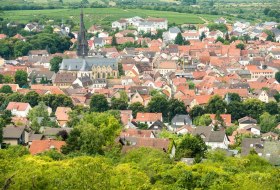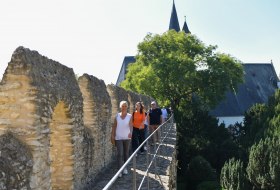
searchMenu



The Offstein Local History Museum's collection focuses on the history of the Offstein clay works and its tiles. The Art Nouveau tiles from the Offstein clay works are used in the Bad Nauheim Sprudelhof, among other places, which demonstrates their supra-regional significance and high artistic value. In addition, the museum collects and displays documents, media and objects relating to the history of the village and village life 30 and more years ago as a permanent exhibition. A complete shoemaker's workshop from this period deserves special…

The pink Heisje The large Weinbergsheisje was commissioned in 1766 by Unterfauth Hirschel as a shelter made of quarry stones with a barrel roof. Renovation in 2009: The walls were plastered white, the roof was originally red. Because the color was not enough, the roof was pink - hence the name! Name: "The Pink Heisje" The design: Weinbergsheisje with barrel roof Material: quarry stone (limestone). Description: Grosses Weinbergsheisje, door opening with a type of doorframe made of quarry stone. Thick walls, the…

The Ellernhof has been family-run for generations and has developed from a mixed agricultural operation to a pure winery with hotel. The vaulted cellar is in this case a barrel vault, a rather rare building in Rheinhessen. General information about Rheinhessen cow chapels The origin of the typical Rheinhessen vaults goes back to the early 19th century. At that time, farmers wanted to increase the yield of their cattle by keeping them in stables and use the leftovers as fertiliser for their fields. Initially, the cattle were housed…

First mentioned in 1413 and thus the oldest mill in Monsheim. The mill was converted into an electricity plant in 1900. The first electric current in Monsheim was produced here. The landowner at this time was Hermann Finger. A special feature of the mill was the historical boundary between Monsheim and Kriegsheim, which ran right through the middle of the estate. Since about 1920, the mill has been owned by the Milch family, who successfully run a restaurant and wine-growing business here. Text taken from the Monsheim tour with kind…

The motorhome site offers a power supply (2.00 EUR/hour) and facilities for supply and disposal. It is an ideal starting point for excursions to Mainz, Bingen or Bad Kreuznach. The nearest shopping facilities are just 100 metres away. -Open all year round -38 pitches -Subsoil: interlocking paving -9,00 EUR per motorhome and night -3,00 Eur electricity per 24 hours -disposal for transients 3,00€ -disposal per night 9,00€ -free bottle of wine on arrival

The all-around accessible main wall was mainly constructed in the 15th century. Its most vulnerable flank at the Mainzer Berg was strengthened by the addition of a Zwinger (inner defence gate). The only entrance (at Grabengasse/Kirchgasse) received an outer gate, a so-called “Barbarkane”. The second, southern breach was created in 1873 and provided access to the vineyards. The most salient point is the so-called Malakoff tower - formerly the “Alte Wache” (old guard post) with its dungeon. It offers an impressive…

The Arch of Dativius Victor is one of the most important reconstructed Roman monuments in Germany. The original arch is now on display at the Mainz State Museum and the structure on Ernst-Ludwig-Platz is a replica. The 43 cut stones were discovered during construction work at the turn of the 20th century. Archaeologists believe that there were originally 75 such blocks, meaning that only about a third of the arch has survived. It appears that some of the stones were already "recycled" during the Roman times for the…